Auditing Theory and Practice: Ethical and Legal Issues in Auditing
VerifiedAdded on 2020/03/02
|11
|2688
|242
Report
AI Summary
This report delves into the ethical and legal challenges faced by auditors, using a case study to illustrate key concepts. The report begins with an executive summary highlighting the application of the American Accounting Association (AAA) Ethical Decision Model to resolve ethical dilemmas within the auditing profession, emphasizing the importance of aligning actions with principles and values. It then meticulously applies the AAA model to a specific case, identifying ethical issues like auditor independence and conflicts of interest, and evaluating alternative courses of action based on norms, principles, and values. Furthermore, the report examines the common law of negligence in auditing, focusing on the aspects of due care and duty of care. It explains how auditors' failures in these areas can lead to legal actions, providing a detailed analysis of how these legal principles apply to the case scenario. The report concludes by discussing potential consequences of various actions and the implications for auditors and stakeholders involved. The report offers a comprehensive understanding of both the ethical and legal dimensions of auditing practice.
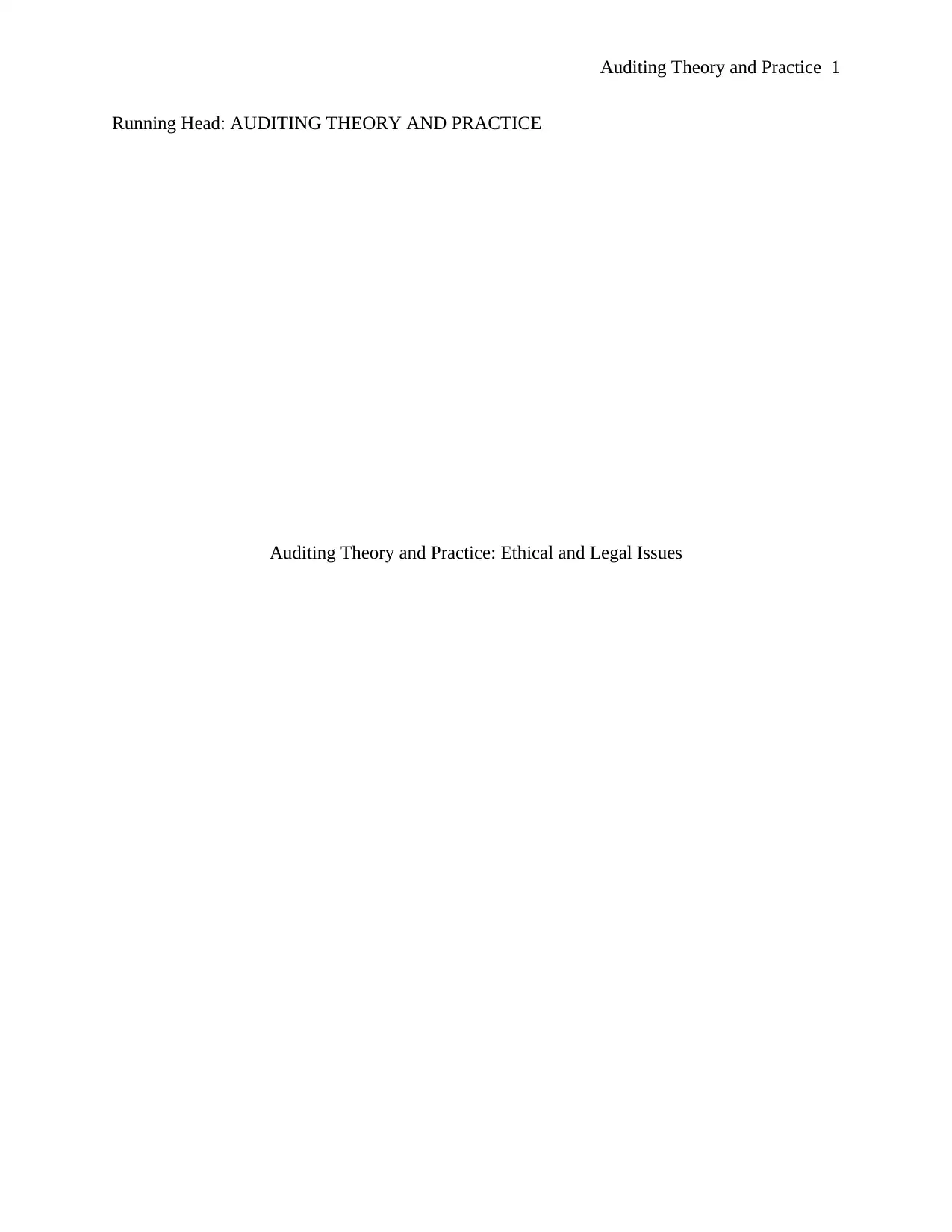
Auditing Theory and Practice 1
Running Head: AUDITING THEORY AND PRACTICE
Auditing Theory and Practice: Ethical and Legal Issues
Running Head: AUDITING THEORY AND PRACTICE
Auditing Theory and Practice: Ethical and Legal Issues
Paraphrase This Document
Need a fresh take? Get an instant paraphrase of this document with our AI Paraphraser
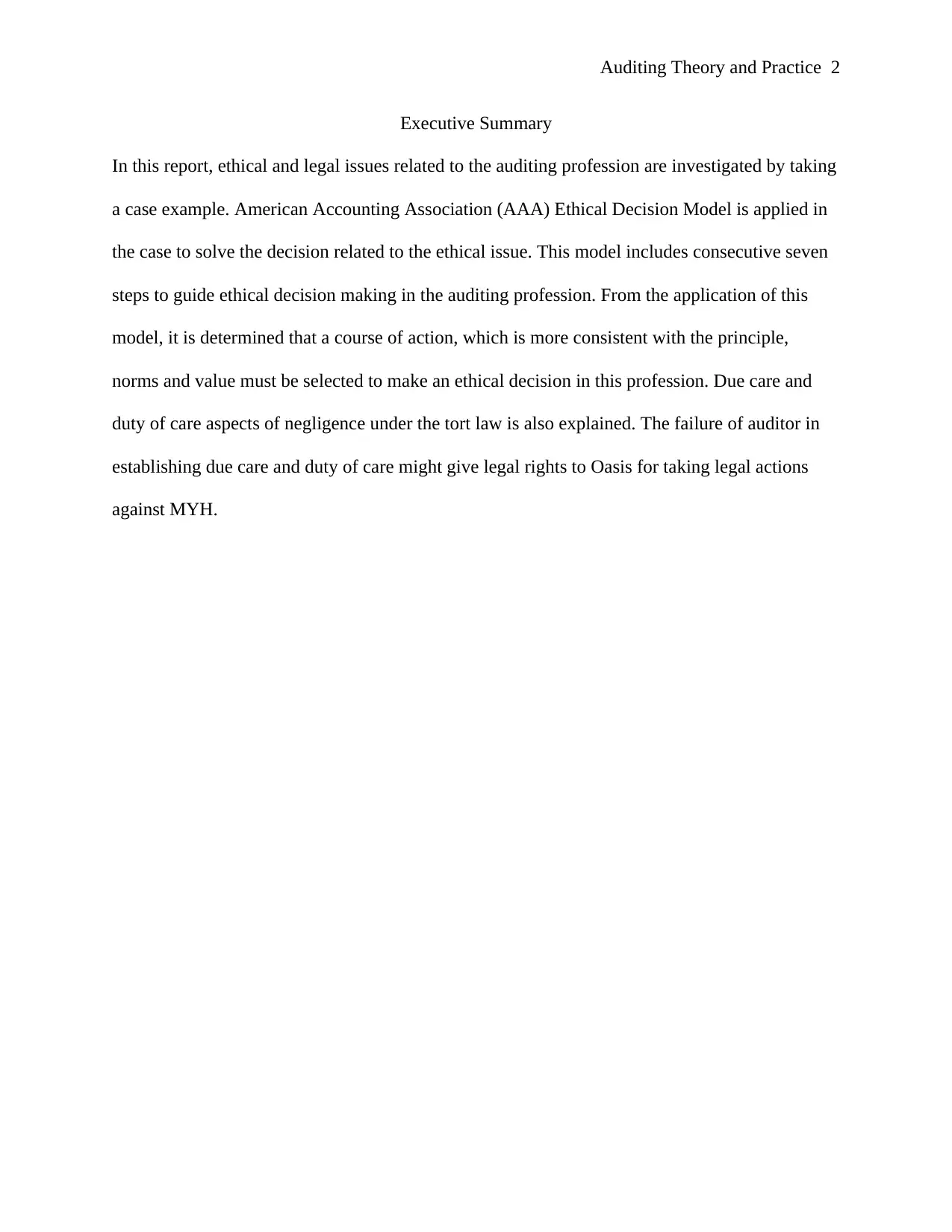
Auditing Theory and Practice 2
Executive Summary
In this report, ethical and legal issues related to the auditing profession are investigated by taking
a case example. American Accounting Association (AAA) Ethical Decision Model is applied in
the case to solve the decision related to the ethical issue. This model includes consecutive seven
steps to guide ethical decision making in the auditing profession. From the application of this
model, it is determined that a course of action, which is more consistent with the principle,
norms and value must be selected to make an ethical decision in this profession. Due care and
duty of care aspects of negligence under the tort law is also explained. The failure of auditor in
establishing due care and duty of care might give legal rights to Oasis for taking legal actions
against MYH.
Executive Summary
In this report, ethical and legal issues related to the auditing profession are investigated by taking
a case example. American Accounting Association (AAA) Ethical Decision Model is applied in
the case to solve the decision related to the ethical issue. This model includes consecutive seven
steps to guide ethical decision making in the auditing profession. From the application of this
model, it is determined that a course of action, which is more consistent with the principle,
norms and value must be selected to make an ethical decision in this profession. Due care and
duty of care aspects of negligence under the tort law is also explained. The failure of auditor in
establishing due care and duty of care might give legal rights to Oasis for taking legal actions
against MYH.
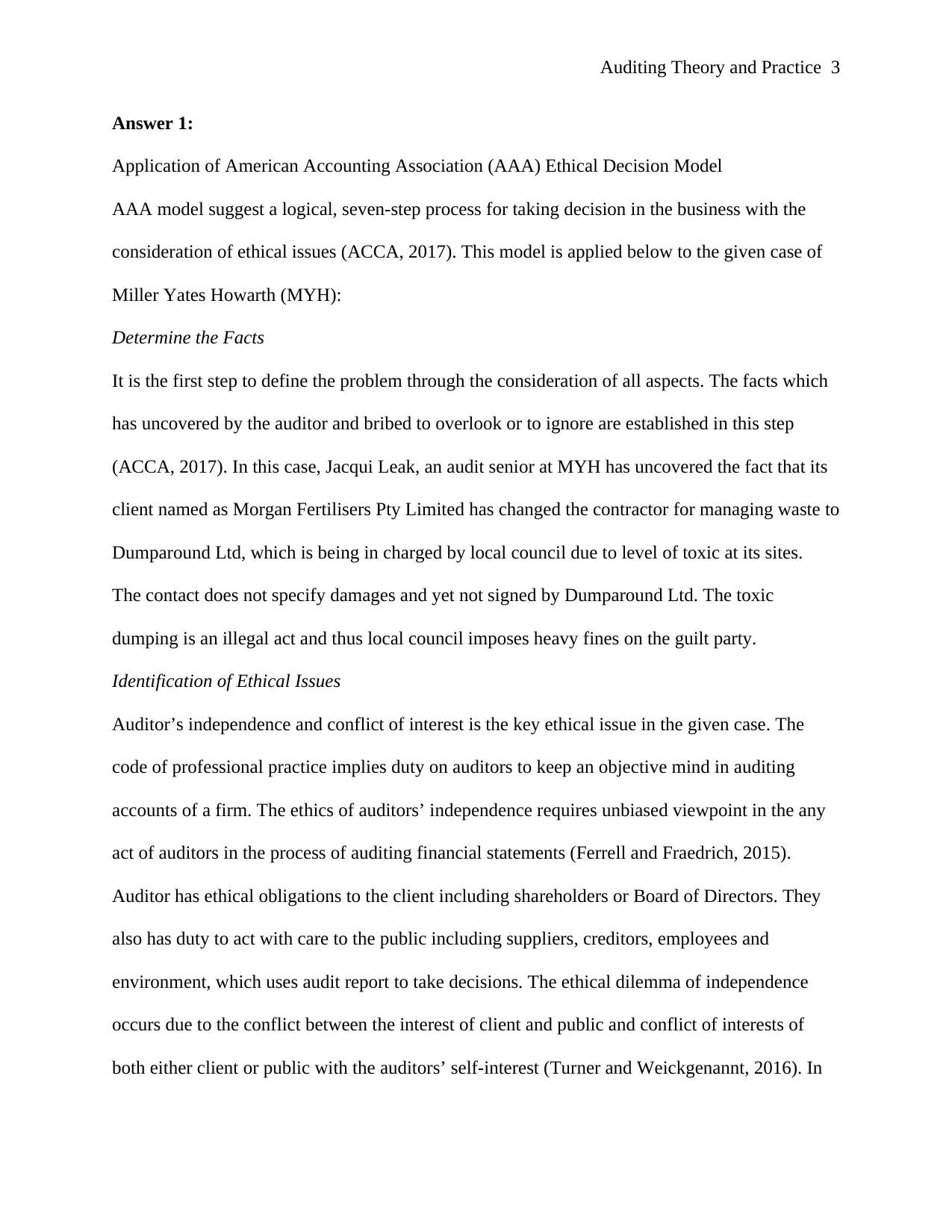
Auditing Theory and Practice 3
Answer 1:
Application of American Accounting Association (AAA) Ethical Decision Model
AAA model suggest a logical, seven-step process for taking decision in the business with the
consideration of ethical issues (ACCA, 2017). This model is applied below to the given case of
Miller Yates Howarth (MYH):
Determine the Facts
It is the first step to define the problem through the consideration of all aspects. The facts which
has uncovered by the auditor and bribed to overlook or to ignore are established in this step
(ACCA, 2017). In this case, Jacqui Leak, an audit senior at MYH has uncovered the fact that its
client named as Morgan Fertilisers Pty Limited has changed the contractor for managing waste to
Dumparound Ltd, which is being in charged by local council due to level of toxic at its sites.
The contact does not specify damages and yet not signed by Dumparound Ltd. The toxic
dumping is an illegal act and thus local council imposes heavy fines on the guilt party.
Identification of Ethical Issues
Auditor’s independence and conflict of interest is the key ethical issue in the given case. The
code of professional practice implies duty on auditors to keep an objective mind in auditing
accounts of a firm. The ethics of auditors’ independence requires unbiased viewpoint in the any
act of auditors in the process of auditing financial statements (Ferrell and Fraedrich, 2015).
Auditor has ethical obligations to the client including shareholders or Board of Directors. They
also has duty to act with care to the public including suppliers, creditors, employees and
environment, which uses audit report to take decisions. The ethical dilemma of independence
occurs due to the conflict between the interest of client and public and conflict of interests of
both either client or public with the auditors’ self-interest (Turner and Weickgenannt, 2016). In
Answer 1:
Application of American Accounting Association (AAA) Ethical Decision Model
AAA model suggest a logical, seven-step process for taking decision in the business with the
consideration of ethical issues (ACCA, 2017). This model is applied below to the given case of
Miller Yates Howarth (MYH):
Determine the Facts
It is the first step to define the problem through the consideration of all aspects. The facts which
has uncovered by the auditor and bribed to overlook or to ignore are established in this step
(ACCA, 2017). In this case, Jacqui Leak, an audit senior at MYH has uncovered the fact that its
client named as Morgan Fertilisers Pty Limited has changed the contractor for managing waste to
Dumparound Ltd, which is being in charged by local council due to level of toxic at its sites.
The contact does not specify damages and yet not signed by Dumparound Ltd. The toxic
dumping is an illegal act and thus local council imposes heavy fines on the guilt party.
Identification of Ethical Issues
Auditor’s independence and conflict of interest is the key ethical issue in the given case. The
code of professional practice implies duty on auditors to keep an objective mind in auditing
accounts of a firm. The ethics of auditors’ independence requires unbiased viewpoint in the any
act of auditors in the process of auditing financial statements (Ferrell and Fraedrich, 2015).
Auditor has ethical obligations to the client including shareholders or Board of Directors. They
also has duty to act with care to the public including suppliers, creditors, employees and
environment, which uses audit report to take decisions. The ethical dilemma of independence
occurs due to the conflict between the interest of client and public and conflict of interests of
both either client or public with the auditors’ self-interest (Turner and Weickgenannt, 2016). In
⊘ This is a preview!⊘
Do you want full access?
Subscribe today to unlock all pages.

Trusted by 1+ million students worldwide
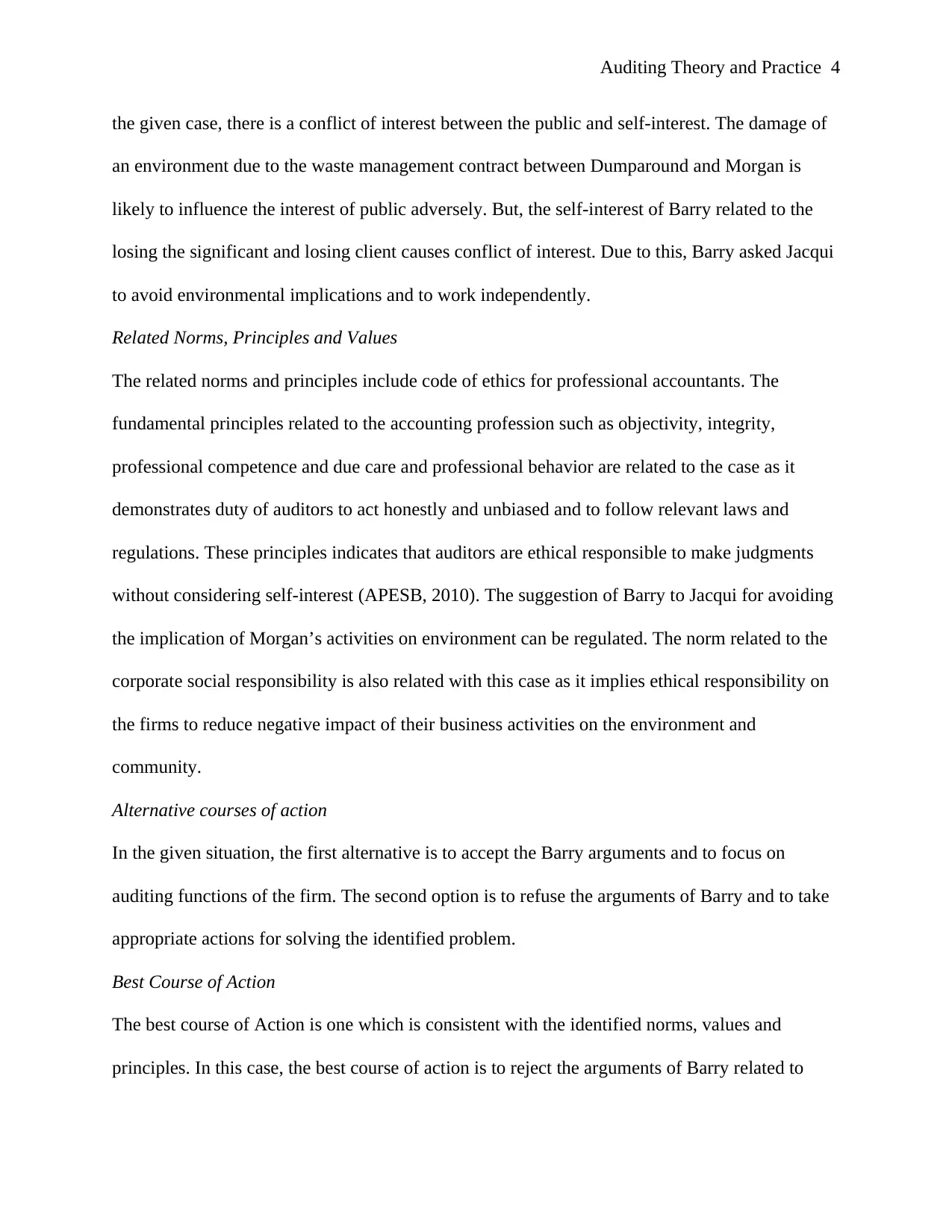
Auditing Theory and Practice 4
the given case, there is a conflict of interest between the public and self-interest. The damage of
an environment due to the waste management contract between Dumparound and Morgan is
likely to influence the interest of public adversely. But, the self-interest of Barry related to the
losing the significant and losing client causes conflict of interest. Due to this, Barry asked Jacqui
to avoid environmental implications and to work independently.
Related Norms, Principles and Values
The related norms and principles include code of ethics for professional accountants. The
fundamental principles related to the accounting profession such as objectivity, integrity,
professional competence and due care and professional behavior are related to the case as it
demonstrates duty of auditors to act honestly and unbiased and to follow relevant laws and
regulations. These principles indicates that auditors are ethical responsible to make judgments
without considering self-interest (APESB, 2010). The suggestion of Barry to Jacqui for avoiding
the implication of Morgan’s activities on environment can be regulated. The norm related to the
corporate social responsibility is also related with this case as it implies ethical responsibility on
the firms to reduce negative impact of their business activities on the environment and
community.
Alternative courses of action
In the given situation, the first alternative is to accept the Barry arguments and to focus on
auditing functions of the firm. The second option is to refuse the arguments of Barry and to take
appropriate actions for solving the identified problem.
Best Course of Action
The best course of Action is one which is consistent with the identified norms, values and
principles. In this case, the best course of action is to reject the arguments of Barry related to
the given case, there is a conflict of interest between the public and self-interest. The damage of
an environment due to the waste management contract between Dumparound and Morgan is
likely to influence the interest of public adversely. But, the self-interest of Barry related to the
losing the significant and losing client causes conflict of interest. Due to this, Barry asked Jacqui
to avoid environmental implications and to work independently.
Related Norms, Principles and Values
The related norms and principles include code of ethics for professional accountants. The
fundamental principles related to the accounting profession such as objectivity, integrity,
professional competence and due care and professional behavior are related to the case as it
demonstrates duty of auditors to act honestly and unbiased and to follow relevant laws and
regulations. These principles indicates that auditors are ethical responsible to make judgments
without considering self-interest (APESB, 2010). The suggestion of Barry to Jacqui for avoiding
the implication of Morgan’s activities on environment can be regulated. The norm related to the
corporate social responsibility is also related with this case as it implies ethical responsibility on
the firms to reduce negative impact of their business activities on the environment and
community.
Alternative courses of action
In the given situation, the first alternative is to accept the Barry arguments and to focus on
auditing functions of the firm. The second option is to refuse the arguments of Barry and to take
appropriate actions for solving the identified problem.
Best Course of Action
The best course of Action is one which is consistent with the identified norms, values and
principles. In this case, the best course of action is to reject the arguments of Barry related to
Paraphrase This Document
Need a fresh take? Get an instant paraphrase of this document with our AI Paraphraser
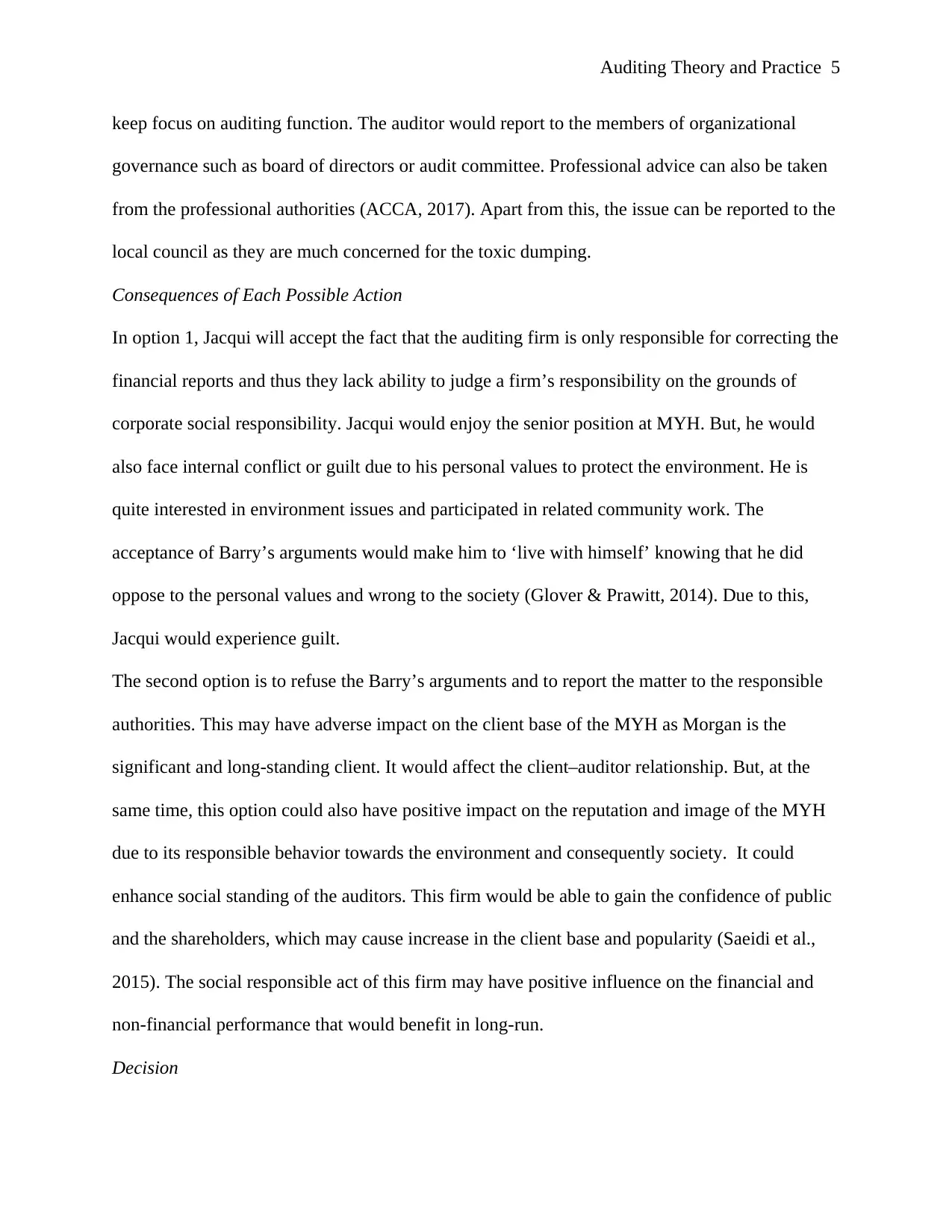
Auditing Theory and Practice 5
keep focus on auditing function. The auditor would report to the members of organizational
governance such as board of directors or audit committee. Professional advice can also be taken
from the professional authorities (ACCA, 2017). Apart from this, the issue can be reported to the
local council as they are much concerned for the toxic dumping.
Consequences of Each Possible Action
In option 1, Jacqui will accept the fact that the auditing firm is only responsible for correcting the
financial reports and thus they lack ability to judge a firm’s responsibility on the grounds of
corporate social responsibility. Jacqui would enjoy the senior position at MYH. But, he would
also face internal conflict or guilt due to his personal values to protect the environment. He is
quite interested in environment issues and participated in related community work. The
acceptance of Barry’s arguments would make him to ‘live with himself’ knowing that he did
oppose to the personal values and wrong to the society (Glover & Prawitt, 2014). Due to this,
Jacqui would experience guilt.
The second option is to refuse the Barry’s arguments and to report the matter to the responsible
authorities. This may have adverse impact on the client base of the MYH as Morgan is the
significant and long-standing client. It would affect the client–auditor relationship. But, at the
same time, this option could also have positive impact on the reputation and image of the MYH
due to its responsible behavior towards the environment and consequently society. It could
enhance social standing of the auditors. This firm would be able to gain the confidence of public
and the shareholders, which may cause increase in the client base and popularity (Saeidi et al.,
2015). The social responsible act of this firm may have positive influence on the financial and
non-financial performance that would benefit in long-run.
Decision
keep focus on auditing function. The auditor would report to the members of organizational
governance such as board of directors or audit committee. Professional advice can also be taken
from the professional authorities (ACCA, 2017). Apart from this, the issue can be reported to the
local council as they are much concerned for the toxic dumping.
Consequences of Each Possible Action
In option 1, Jacqui will accept the fact that the auditing firm is only responsible for correcting the
financial reports and thus they lack ability to judge a firm’s responsibility on the grounds of
corporate social responsibility. Jacqui would enjoy the senior position at MYH. But, he would
also face internal conflict or guilt due to his personal values to protect the environment. He is
quite interested in environment issues and participated in related community work. The
acceptance of Barry’s arguments would make him to ‘live with himself’ knowing that he did
oppose to the personal values and wrong to the society (Glover & Prawitt, 2014). Due to this,
Jacqui would experience guilt.
The second option is to refuse the Barry’s arguments and to report the matter to the responsible
authorities. This may have adverse impact on the client base of the MYH as Morgan is the
significant and long-standing client. It would affect the client–auditor relationship. But, at the
same time, this option could also have positive impact on the reputation and image of the MYH
due to its responsible behavior towards the environment and consequently society. It could
enhance social standing of the auditors. This firm would be able to gain the confidence of public
and the shareholders, which may cause increase in the client base and popularity (Saeidi et al.,
2015). The social responsible act of this firm may have positive influence on the financial and
non-financial performance that would benefit in long-run.
Decision
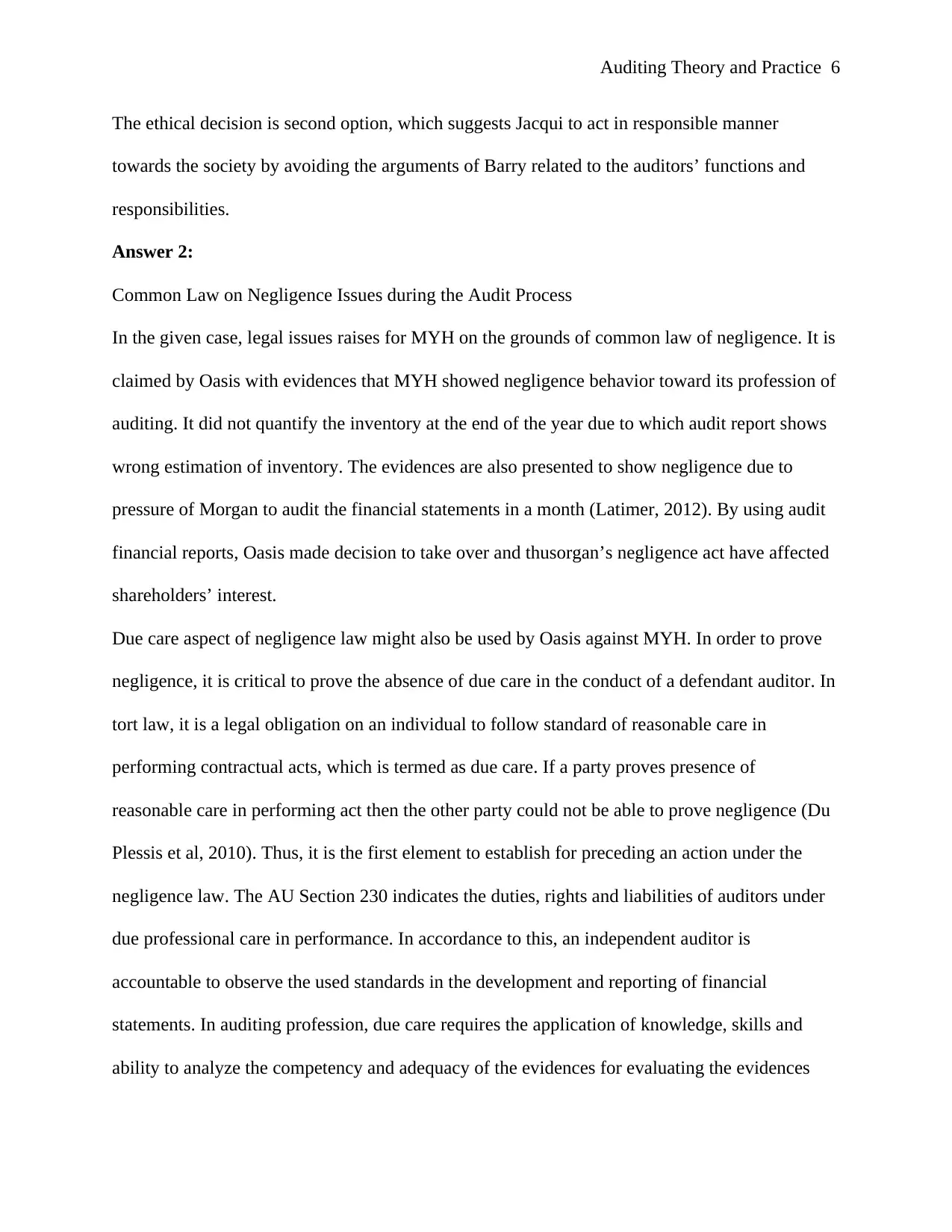
Auditing Theory and Practice 6
The ethical decision is second option, which suggests Jacqui to act in responsible manner
towards the society by avoiding the arguments of Barry related to the auditors’ functions and
responsibilities.
Answer 2:
Common Law on Negligence Issues during the Audit Process
In the given case, legal issues raises for MYH on the grounds of common law of negligence. It is
claimed by Oasis with evidences that MYH showed negligence behavior toward its profession of
auditing. It did not quantify the inventory at the end of the year due to which audit report shows
wrong estimation of inventory. The evidences are also presented to show negligence due to
pressure of Morgan to audit the financial statements in a month (Latimer, 2012). By using audit
financial reports, Oasis made decision to take over and thusorgan’s negligence act have affected
shareholders’ interest.
Due care aspect of negligence law might also be used by Oasis against MYH. In order to prove
negligence, it is critical to prove the absence of due care in the conduct of a defendant auditor. In
tort law, it is a legal obligation on an individual to follow standard of reasonable care in
performing contractual acts, which is termed as due care. If a party proves presence of
reasonable care in performing act then the other party could not be able to prove negligence (Du
Plessis et al, 2010). Thus, it is the first element to establish for preceding an action under the
negligence law. The AU Section 230 indicates the duties, rights and liabilities of auditors under
due professional care in performance. In accordance to this, an independent auditor is
accountable to observe the used standards in the development and reporting of financial
statements. In auditing profession, due care requires the application of knowledge, skills and
ability to analyze the competency and adequacy of the evidences for evaluating the evidences
The ethical decision is second option, which suggests Jacqui to act in responsible manner
towards the society by avoiding the arguments of Barry related to the auditors’ functions and
responsibilities.
Answer 2:
Common Law on Negligence Issues during the Audit Process
In the given case, legal issues raises for MYH on the grounds of common law of negligence. It is
claimed by Oasis with evidences that MYH showed negligence behavior toward its profession of
auditing. It did not quantify the inventory at the end of the year due to which audit report shows
wrong estimation of inventory. The evidences are also presented to show negligence due to
pressure of Morgan to audit the financial statements in a month (Latimer, 2012). By using audit
financial reports, Oasis made decision to take over and thusorgan’s negligence act have affected
shareholders’ interest.
Due care aspect of negligence law might also be used by Oasis against MYH. In order to prove
negligence, it is critical to prove the absence of due care in the conduct of a defendant auditor. In
tort law, it is a legal obligation on an individual to follow standard of reasonable care in
performing contractual acts, which is termed as due care. If a party proves presence of
reasonable care in performing act then the other party could not be able to prove negligence (Du
Plessis et al, 2010). Thus, it is the first element to establish for preceding an action under the
negligence law. The AU Section 230 indicates the duties, rights and liabilities of auditors under
due professional care in performance. In accordance to this, an independent auditor is
accountable to observe the used standards in the development and reporting of financial
statements. In auditing profession, due care requires the application of knowledge, skills and
ability to analyze the competency and adequacy of the evidences for evaluating the evidences
⊘ This is a preview!⊘
Do you want full access?
Subscribe today to unlock all pages.

Trusted by 1+ million students worldwide
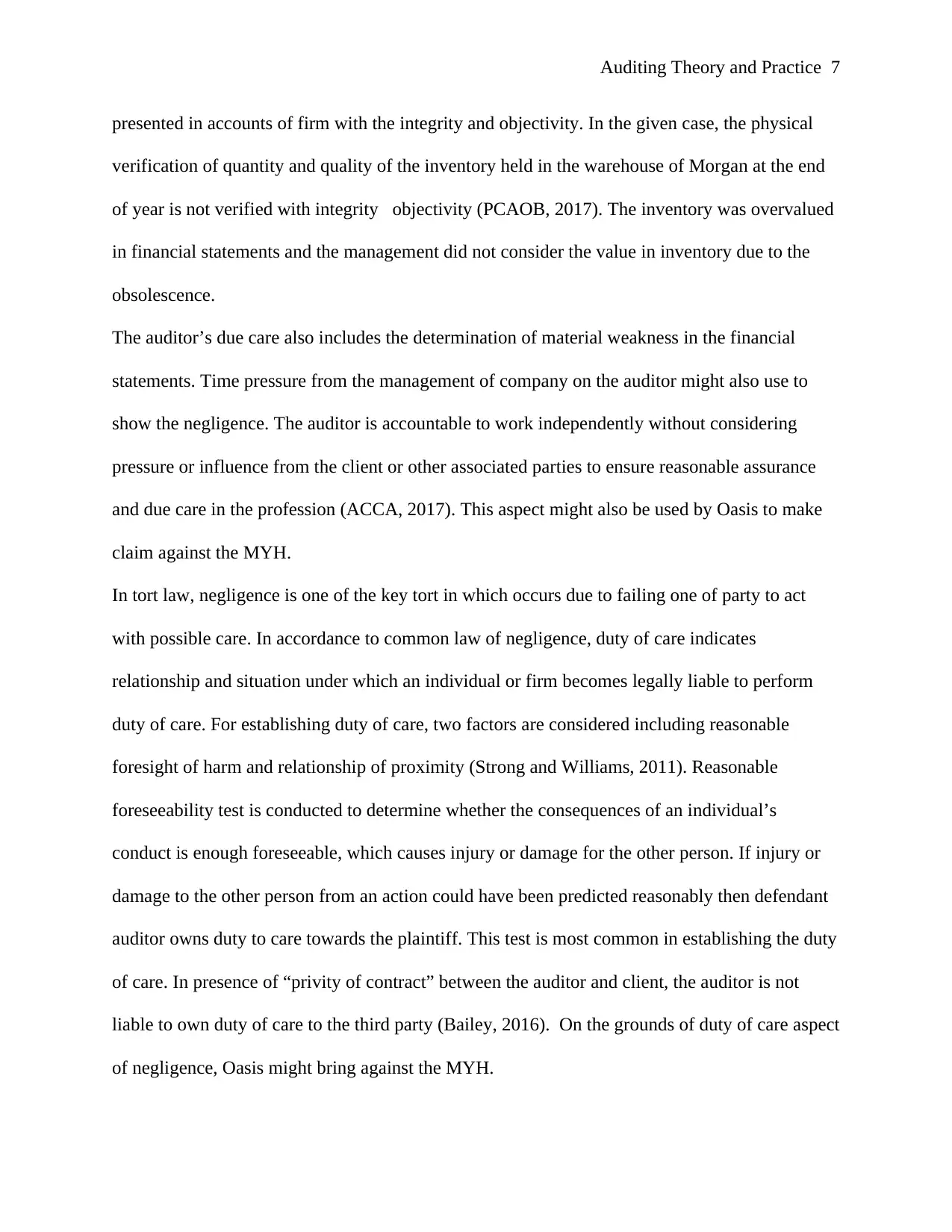
Auditing Theory and Practice 7
presented in accounts of firm with the integrity and objectivity. In the given case, the physical
verification of quantity and quality of the inventory held in the warehouse of Morgan at the end
of year is not verified with integrity objectivity (PCAOB, 2017). The inventory was overvalued
in financial statements and the management did not consider the value in inventory due to the
obsolescence.
The auditor’s due care also includes the determination of material weakness in the financial
statements. Time pressure from the management of company on the auditor might also use to
show the negligence. The auditor is accountable to work independently without considering
pressure or influence from the client or other associated parties to ensure reasonable assurance
and due care in the profession (ACCA, 2017). This aspect might also be used by Oasis to make
claim against the MYH.
In tort law, negligence is one of the key tort in which occurs due to failing one of party to act
with possible care. In accordance to common law of negligence, duty of care indicates
relationship and situation under which an individual or firm becomes legally liable to perform
duty of care. For establishing duty of care, two factors are considered including reasonable
foresight of harm and relationship of proximity (Strong and Williams, 2011). Reasonable
foreseeability test is conducted to determine whether the consequences of an individual’s
conduct is enough foreseeable, which causes injury or damage for the other person. If injury or
damage to the other person from an action could have been predicted reasonably then defendant
auditor owns duty to care towards the plaintiff. This test is most common in establishing the duty
of care. In presence of “privity of contract” between the auditor and client, the auditor is not
liable to own duty of care to the third party (Bailey, 2016). On the grounds of duty of care aspect
of negligence, Oasis might bring against the MYH.
presented in accounts of firm with the integrity and objectivity. In the given case, the physical
verification of quantity and quality of the inventory held in the warehouse of Morgan at the end
of year is not verified with integrity objectivity (PCAOB, 2017). The inventory was overvalued
in financial statements and the management did not consider the value in inventory due to the
obsolescence.
The auditor’s due care also includes the determination of material weakness in the financial
statements. Time pressure from the management of company on the auditor might also use to
show the negligence. The auditor is accountable to work independently without considering
pressure or influence from the client or other associated parties to ensure reasonable assurance
and due care in the profession (ACCA, 2017). This aspect might also be used by Oasis to make
claim against the MYH.
In tort law, negligence is one of the key tort in which occurs due to failing one of party to act
with possible care. In accordance to common law of negligence, duty of care indicates
relationship and situation under which an individual or firm becomes legally liable to perform
duty of care. For establishing duty of care, two factors are considered including reasonable
foresight of harm and relationship of proximity (Strong and Williams, 2011). Reasonable
foreseeability test is conducted to determine whether the consequences of an individual’s
conduct is enough foreseeable, which causes injury or damage for the other person. If injury or
damage to the other person from an action could have been predicted reasonably then defendant
auditor owns duty to care towards the plaintiff. This test is most common in establishing the duty
of care. In presence of “privity of contract” between the auditor and client, the auditor is not
liable to own duty of care to the third party (Bailey, 2016). On the grounds of duty of care aspect
of negligence, Oasis might bring against the MYH.
Paraphrase This Document
Need a fresh take? Get an instant paraphrase of this document with our AI Paraphraser
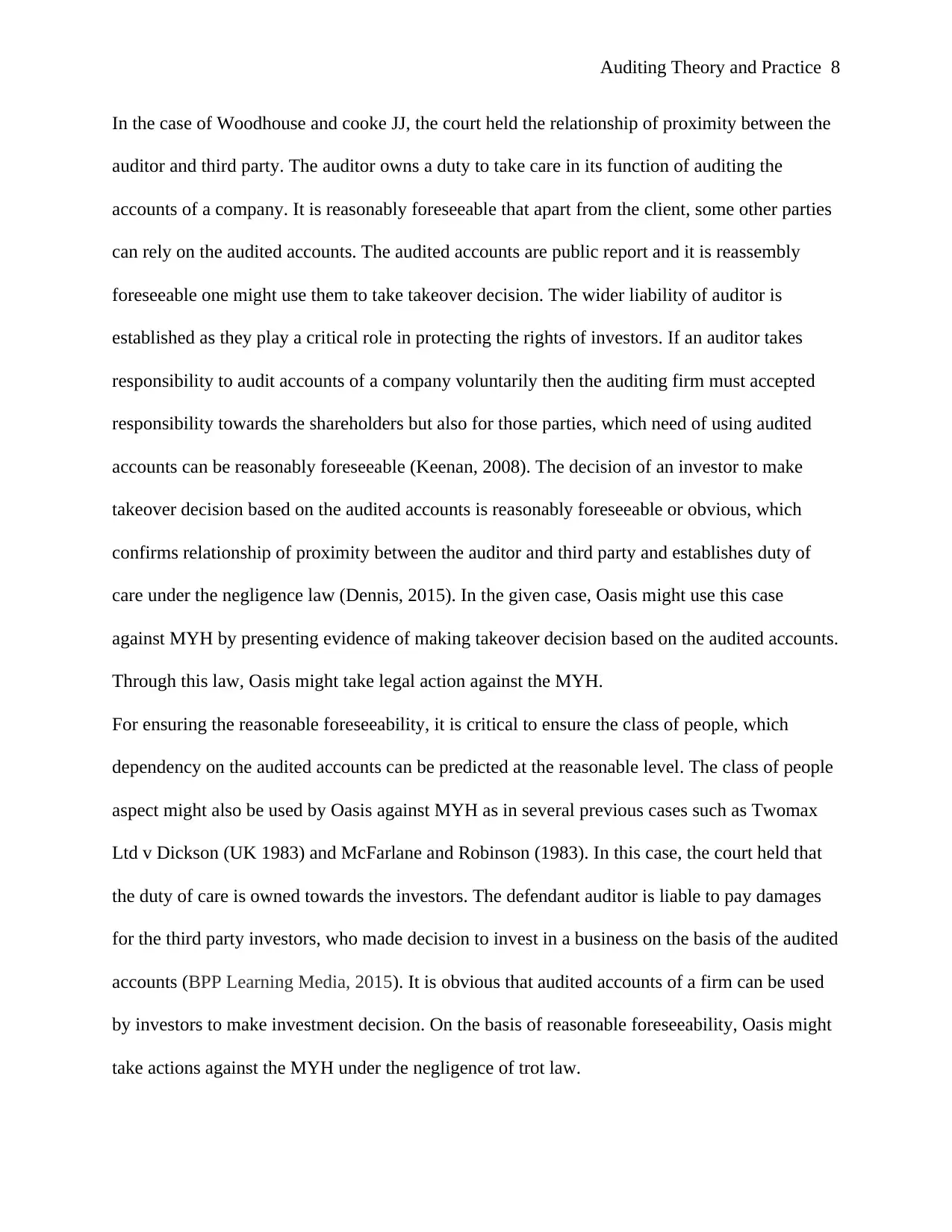
Auditing Theory and Practice 8
In the case of Woodhouse and cooke JJ, the court held the relationship of proximity between the
auditor and third party. The auditor owns a duty to take care in its function of auditing the
accounts of a company. It is reasonably foreseeable that apart from the client, some other parties
can rely on the audited accounts. The audited accounts are public report and it is reassembly
foreseeable one might use them to take takeover decision. The wider liability of auditor is
established as they play a critical role in protecting the rights of investors. If an auditor takes
responsibility to audit accounts of a company voluntarily then the auditing firm must accepted
responsibility towards the shareholders but also for those parties, which need of using audited
accounts can be reasonably foreseeable (Keenan, 2008). The decision of an investor to make
takeover decision based on the audited accounts is reasonably foreseeable or obvious, which
confirms relationship of proximity between the auditor and third party and establishes duty of
care under the negligence law (Dennis, 2015). In the given case, Oasis might use this case
against MYH by presenting evidence of making takeover decision based on the audited accounts.
Through this law, Oasis might take legal action against the MYH.
For ensuring the reasonable foreseeability, it is critical to ensure the class of people, which
dependency on the audited accounts can be predicted at the reasonable level. The class of people
aspect might also be used by Oasis against MYH as in several previous cases such as Twomax
Ltd v Dickson (UK 1983) and McFarlane and Robinson (1983). In this case, the court held that
the duty of care is owned towards the investors. The defendant auditor is liable to pay damages
for the third party investors, who made decision to invest in a business on the basis of the audited
accounts (BPP Learning Media, 2015). It is obvious that audited accounts of a firm can be used
by investors to make investment decision. On the basis of reasonable foreseeability, Oasis might
take actions against the MYH under the negligence of trot law.
In the case of Woodhouse and cooke JJ, the court held the relationship of proximity between the
auditor and third party. The auditor owns a duty to take care in its function of auditing the
accounts of a company. It is reasonably foreseeable that apart from the client, some other parties
can rely on the audited accounts. The audited accounts are public report and it is reassembly
foreseeable one might use them to take takeover decision. The wider liability of auditor is
established as they play a critical role in protecting the rights of investors. If an auditor takes
responsibility to audit accounts of a company voluntarily then the auditing firm must accepted
responsibility towards the shareholders but also for those parties, which need of using audited
accounts can be reasonably foreseeable (Keenan, 2008). The decision of an investor to make
takeover decision based on the audited accounts is reasonably foreseeable or obvious, which
confirms relationship of proximity between the auditor and third party and establishes duty of
care under the negligence law (Dennis, 2015). In the given case, Oasis might use this case
against MYH by presenting evidence of making takeover decision based on the audited accounts.
Through this law, Oasis might take legal action against the MYH.
For ensuring the reasonable foreseeability, it is critical to ensure the class of people, which
dependency on the audited accounts can be predicted at the reasonable level. The class of people
aspect might also be used by Oasis against MYH as in several previous cases such as Twomax
Ltd v Dickson (UK 1983) and McFarlane and Robinson (1983). In this case, the court held that
the duty of care is owned towards the investors. The defendant auditor is liable to pay damages
for the third party investors, who made decision to invest in a business on the basis of the audited
accounts (BPP Learning Media, 2015). It is obvious that audited accounts of a firm can be used
by investors to make investment decision. On the basis of reasonable foreseeability, Oasis might
take actions against the MYH under the negligence of trot law.
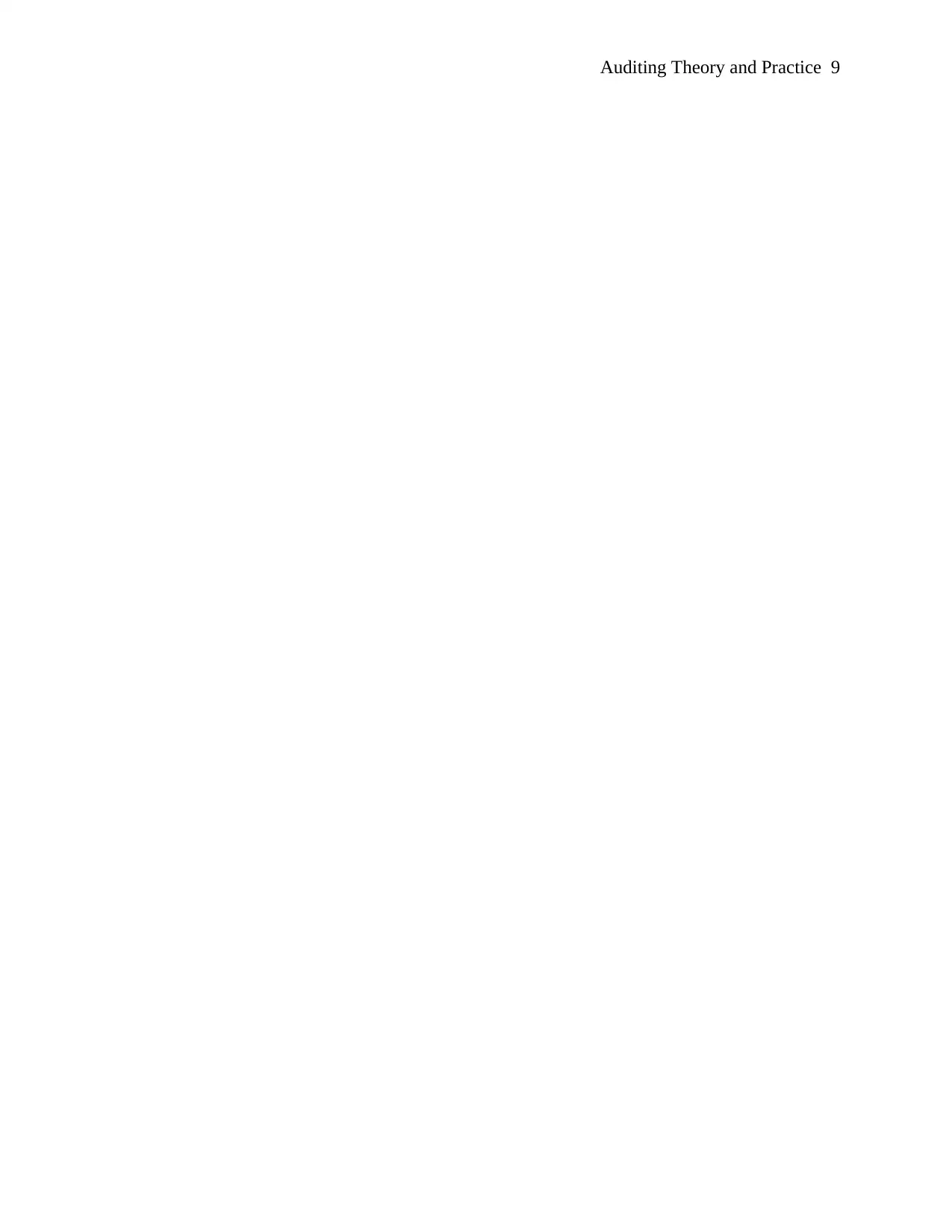
Auditing Theory and Practice 9
⊘ This is a preview!⊘
Do you want full access?
Subscribe today to unlock all pages.

Trusted by 1+ million students worldwide
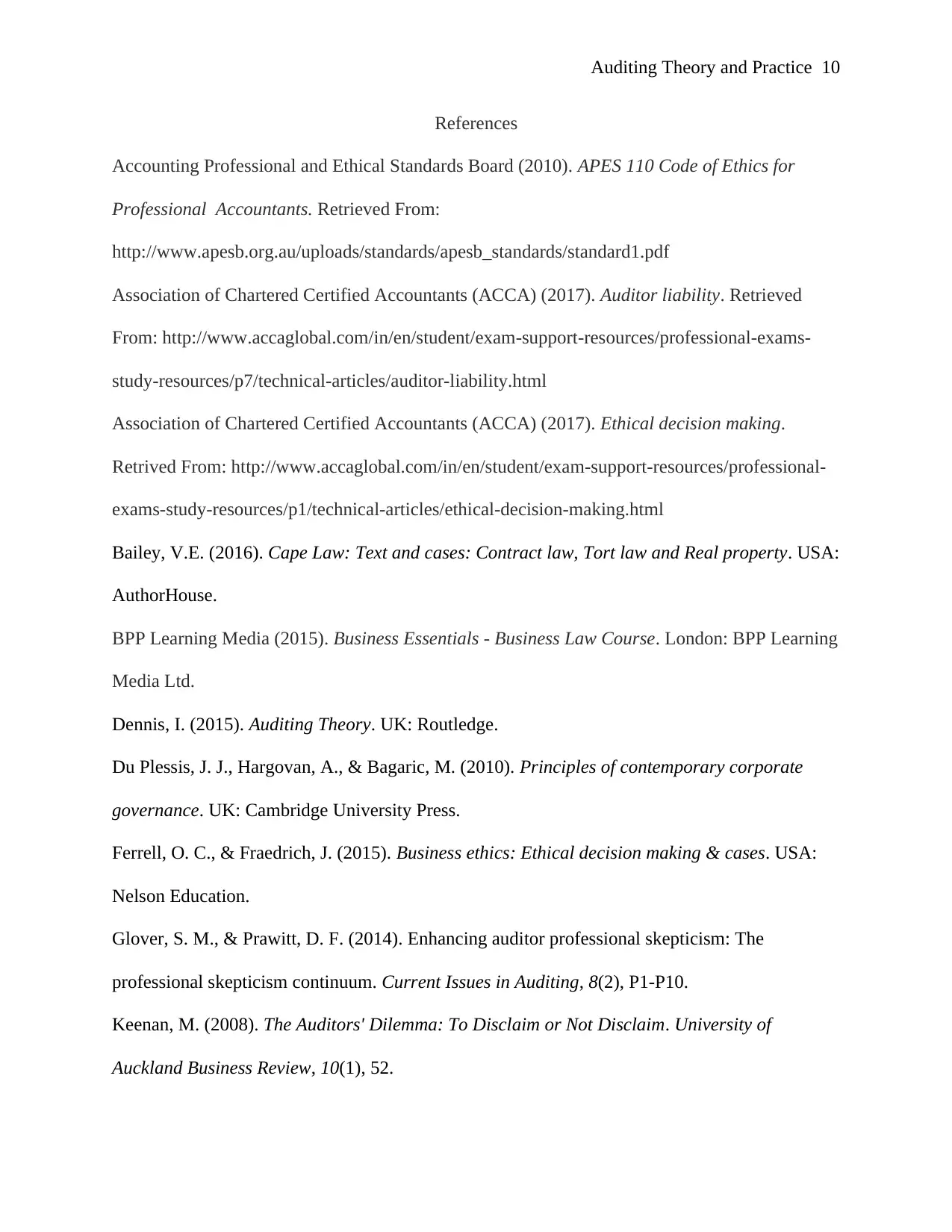
Auditing Theory and Practice 10
References
Accounting Professional and Ethical Standards Board (2010). APES 110 Code of Ethics for
Professional Accountants. Retrieved From:
http://www.apesb.org.au/uploads/standards/apesb_standards/standard1.pdf
Association of Chartered Certified Accountants (ACCA) (2017). Auditor liability. Retrieved
From: http://www.accaglobal.com/in/en/student/exam-support-resources/professional-exams-
study-resources/p7/technical-articles/auditor-liability.html
Association of Chartered Certified Accountants (ACCA) (2017). Ethical decision making.
Retrived From: http://www.accaglobal.com/in/en/student/exam-support-resources/professional-
exams-study-resources/p1/technical-articles/ethical-decision-making.html
Bailey, V.E. (2016). Cape Law: Text and cases: Contract law, Tort law and Real property. USA:
AuthorHouse.
BPP Learning Media (2015). Business Essentials - Business Law Course. London: BPP Learning
Media Ltd.
Dennis, I. (2015). Auditing Theory. UK: Routledge.
Du Plessis, J. J., Hargovan, A., & Bagaric, M. (2010). Principles of contemporary corporate
governance. UK: Cambridge University Press.
Ferrell, O. C., & Fraedrich, J. (2015). Business ethics: Ethical decision making & cases. USA:
Nelson Education.
Glover, S. M., & Prawitt, D. F. (2014). Enhancing auditor professional skepticism: The
professional skepticism continuum. Current Issues in Auditing, 8(2), P1-P10.
Keenan, M. (2008). The Auditors' Dilemma: To Disclaim or Not Disclaim. University of
Auckland Business Review, 10(1), 52.
References
Accounting Professional and Ethical Standards Board (2010). APES 110 Code of Ethics for
Professional Accountants. Retrieved From:
http://www.apesb.org.au/uploads/standards/apesb_standards/standard1.pdf
Association of Chartered Certified Accountants (ACCA) (2017). Auditor liability. Retrieved
From: http://www.accaglobal.com/in/en/student/exam-support-resources/professional-exams-
study-resources/p7/technical-articles/auditor-liability.html
Association of Chartered Certified Accountants (ACCA) (2017). Ethical decision making.
Retrived From: http://www.accaglobal.com/in/en/student/exam-support-resources/professional-
exams-study-resources/p1/technical-articles/ethical-decision-making.html
Bailey, V.E. (2016). Cape Law: Text and cases: Contract law, Tort law and Real property. USA:
AuthorHouse.
BPP Learning Media (2015). Business Essentials - Business Law Course. London: BPP Learning
Media Ltd.
Dennis, I. (2015). Auditing Theory. UK: Routledge.
Du Plessis, J. J., Hargovan, A., & Bagaric, M. (2010). Principles of contemporary corporate
governance. UK: Cambridge University Press.
Ferrell, O. C., & Fraedrich, J. (2015). Business ethics: Ethical decision making & cases. USA:
Nelson Education.
Glover, S. M., & Prawitt, D. F. (2014). Enhancing auditor professional skepticism: The
professional skepticism continuum. Current Issues in Auditing, 8(2), P1-P10.
Keenan, M. (2008). The Auditors' Dilemma: To Disclaim or Not Disclaim. University of
Auckland Business Review, 10(1), 52.
Paraphrase This Document
Need a fresh take? Get an instant paraphrase of this document with our AI Paraphraser
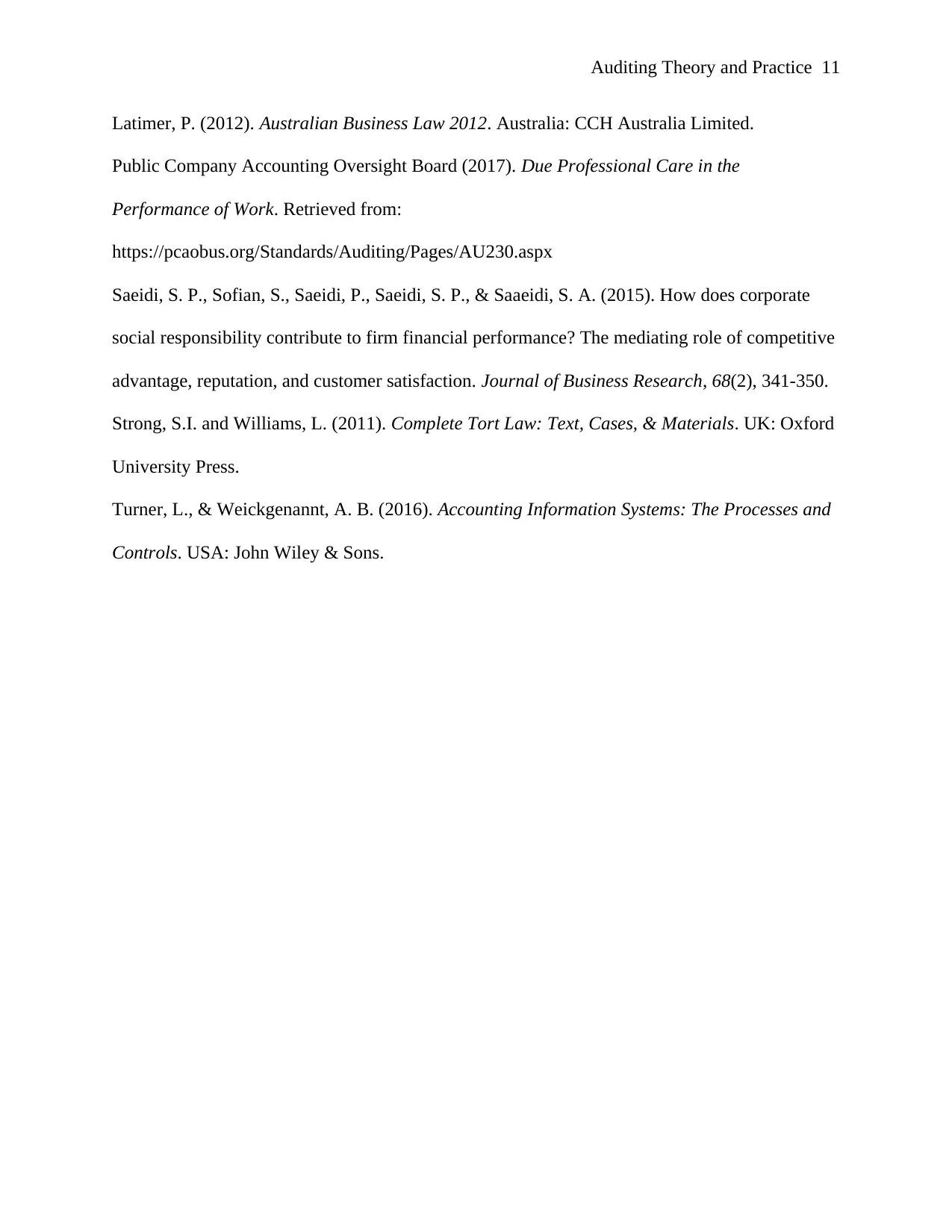
Auditing Theory and Practice 11
Latimer, P. (2012). Australian Business Law 2012. Australia: CCH Australia Limited.
Public Company Accounting Oversight Board (2017). Due Professional Care in the
Performance of Work. Retrieved from:
https://pcaobus.org/Standards/Auditing/Pages/AU230.aspx
Saeidi, S. P., Sofian, S., Saeidi, P., Saeidi, S. P., & Saaeidi, S. A. (2015). How does corporate
social responsibility contribute to firm financial performance? The mediating role of competitive
advantage, reputation, and customer satisfaction. Journal of Business Research, 68(2), 341-350.
Strong, S.I. and Williams, L. (2011). Complete Tort Law: Text, Cases, & Materials. UK: Oxford
University Press.
Turner, L., & Weickgenannt, A. B. (2016). Accounting Information Systems: The Processes and
Controls. USA: John Wiley & Sons.
Latimer, P. (2012). Australian Business Law 2012. Australia: CCH Australia Limited.
Public Company Accounting Oversight Board (2017). Due Professional Care in the
Performance of Work. Retrieved from:
https://pcaobus.org/Standards/Auditing/Pages/AU230.aspx
Saeidi, S. P., Sofian, S., Saeidi, P., Saeidi, S. P., & Saaeidi, S. A. (2015). How does corporate
social responsibility contribute to firm financial performance? The mediating role of competitive
advantage, reputation, and customer satisfaction. Journal of Business Research, 68(2), 341-350.
Strong, S.I. and Williams, L. (2011). Complete Tort Law: Text, Cases, & Materials. UK: Oxford
University Press.
Turner, L., & Weickgenannt, A. B. (2016). Accounting Information Systems: The Processes and
Controls. USA: John Wiley & Sons.
1 out of 11
Related Documents
Your All-in-One AI-Powered Toolkit for Academic Success.
+13062052269
info@desklib.com
Available 24*7 on WhatsApp / Email
![[object Object]](/_next/static/media/star-bottom.7253800d.svg)
Unlock your academic potential
Copyright © 2020–2025 A2Z Services. All Rights Reserved. Developed and managed by ZUCOL.





